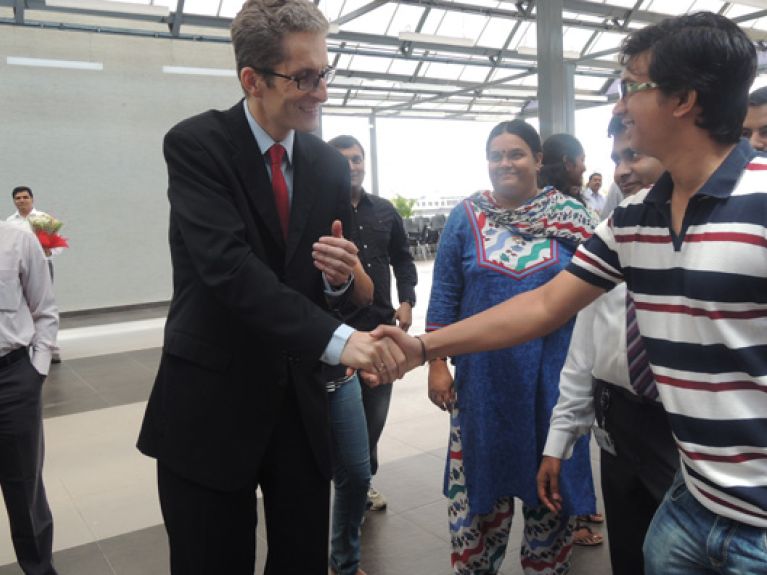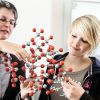How long to get from Stuttgart to Bangalore?
Just the blink of an eye, because digitalisation lets companies carry out research and development in various locations around the globe almost simultaneously. An interview with the Mercedes-Benz-researcher Dr. Jens Cattarius.

Dr Cattarius, Mercedes-Benz Research and Development (MBRDI) in Bangalore, India is the company’s largest research and development facility outside of Germany. You were the Managing Director and CEO until early 2014. What did your job involve?
The development facility was established in 1996. Its location in Bangalore in the south of India puts it in one of the country’s major economic centres. There are numerous international companies situated there and there are many technical universities and research institutes in the region. This has earned the city the reputation of being the Silicon Valley of India. My role was to expand the site and to integrate the competencies into the global research and development portfolio. While I was there, the facility expanded by an annual average of nearly 40%, taking it from an initial workforce of 350 employees to more than 1,300 employees. During that time, we also opened our new R&D facility in the industrial zone of Whitefield. This allowed us to bring together all of our staff who had previously been spread between various office buildings in a business park.
How far away from head office is Bangalore? Or, to put it another way, how does the cooperation work between Bangalore and Stuttgart, on a technical level and with regard to content and time?
The global research and development network is closely interconnected. Thanks to the technical capabilities of digital communication, we are able to bridge almost all geographical distances easily and securely. Our staff in Bangalore are fully integrated into the network and are able to access all systems directly without any significant time delay. Despite the time difference, we can easily manage four to five hours of joint working time, e.g. with the plant in Sindelfingen. And we are always in close contact with our colleagues at the plant by e-mail and telephone or video conferencing.
How important is India in Mercedes-Benz’s global research network?
There are currently 2,000 staff at MBRDI, making it the largest Daimler research and development centre outside of Germany. Work is carried out here on Daimler AG’s research, development and IT in close association with the other R&D centres throughout the world.
What types of work in the Mercedes-Benz global research network are carried out in India? And what can be done better in India than in Germany?
MBRDI’s work focuses on digital development, or virtual engineering. The key areas are CAD design of components and modules, as well as simulation and protection with regard to safety development, validation for electronic/electrical engineering, functional validation and hardware in the loop test stands. The main focus of IT is software development and maintenance, e.g. database-supported systems, which assist our engineers in design and testing. A further key area is support for local suppliers, particularly for interior components. I am convinced that Daimler can increase its competitiveness through MBRDI, because developing know-how in India makes the best use of the strengths of our colleagues in India. They are very methodical and have very good analytical skills. An obvious example is IT, but the same applies to many areas of engineering skill. We are also wanting to bring back into the company know-how which has gone to suppliers. All in all, I can see that MBRDI strengthens the German facilities. I have no doubt that the heart and soul of Mercedes-Benz are in Germany. However, through the work of MBRDI, German engineers have more scope again to develop and promote competing products with innovations. The development of the n-th version does not necessarily have to happen in Germany. The goal is for Daimler and Mercedes-Benz to be at the forefront once again and MBRDI can make a significant contribution to this.
Can you give an example of a successful project from the past?
Our most successful projects are in the areas in which MBRDI is able to display its full strengths. These are, on the one hand, development of methods and tools in simulation and, on the other hand, direct management of local branches of global suppliers. Original Equipment Manufacturers and suppliers are concentrated in the three “automotive clusters”, the National Capital Region (NCR) around the capital Delhi, the Pune/Mumbai region and Bangalore/Chennai. Companies such as Bosch, Continental, Faurecia, Harman, Johnson Control and Magna are located there. We turn to them directly from Bangalore in projects in which the parent companies process volumes at their Indian sites – and we can thus control our suppliers directly.
You are now back at the Sindelfingen plant. What are you doing there?
In my new job, I am responsible for cross-sector services and processes for product development in Group Research & Mercedes-Benz Cars Development. This involves, on the one hand, issues such as vehicle endurance, design of development vehicles, product data documentation and project management support and, on the other hand, control processes for product development such as Mercedes-Benz car product development and change processes. My area of responsibility also includes comprehensive special topics such as the new Daimler Testing and Technology Centre in Immendingen. Just as in Bangalore, the work here in Sindelfingen is completely fascinating and requires my full commitment. India has a rapidly growing market economy and a very young population, and is surrounded by a fascinating spirit of optimism in the business centres such as Bangalore, which also has a great influence on the operating principles of companies there. Staff there are young, well-educated and ambitious – everything is growing, becoming bigger and changing rapidly. The challenges for management are consequently quite different. As well as the substantive technical challenges, one is very much involved with employee turnover and the high personal expectations of staff, who want to be involved from a career perspective in the company’s growth.
Are you still in contact with India?
The time I spent in India left its mark and made a great impression on me, and I am still in very close contact with my colleagues in Bangalore. In my current position, I am also on the board of directors of MBRDI which allows me to continue to be involved in the development of the company.
It was the digital transformation which made this form of collaboration possible in the first place. What other possibilities are beginning to emerge for the future?
Digitalisation of the workplace will continue to progress and we will be networked more and more efficiently in the global Research and Development Association with our branches. This will continue to give us flexibility and speed in the product development process and allow us to globalise our development processes more easily and more efficiently. Digitalisation gives us the proximity to our customers which we need to adapt our products specifically to customer needs, with the flexibility and speed we have gained, something which is a key success factor in global competition.
Finally, do you use the benefits of the digital society outside of work as well?
I have been using the Internet in my work for many years already and I use the benefits of the digital world away from work as well, as you would expect. I use social networks to keep in touch with friends and family who are far away in geographical terms – and I seldom buy anything online, for example, without first reading reviews on the Internet. Online banking and mobile Internet are an indispensable part of my life. ▪
Interview: Martin Orth

